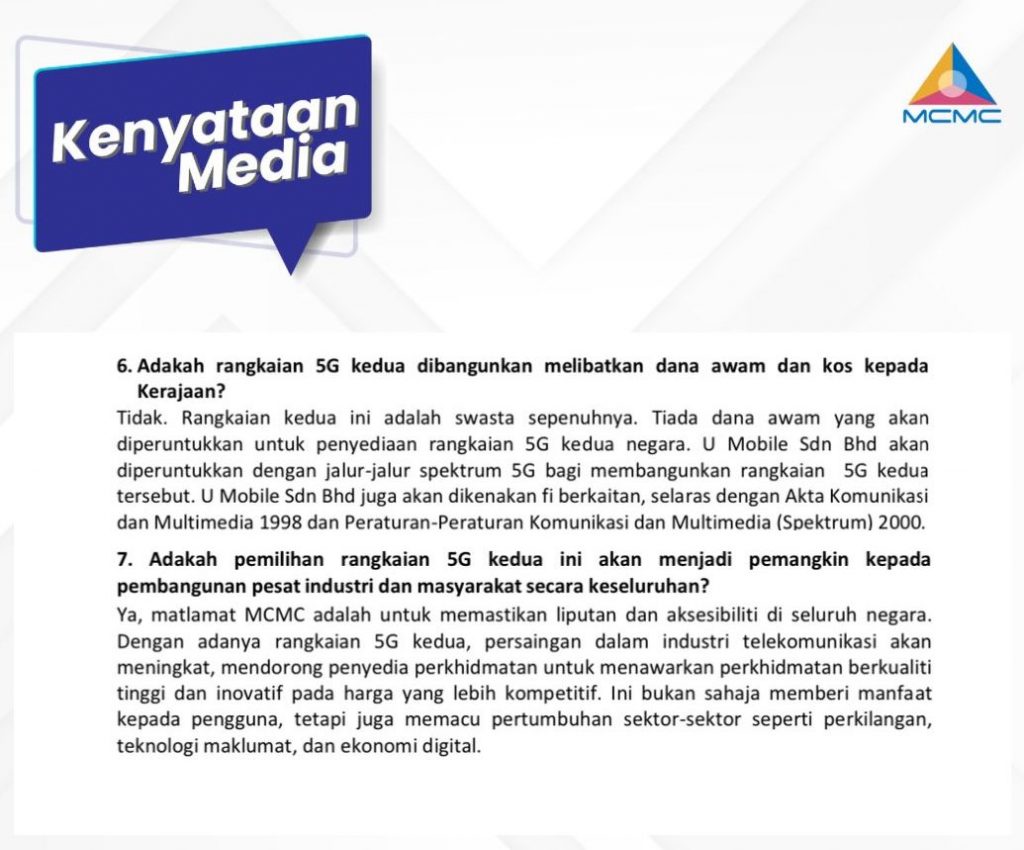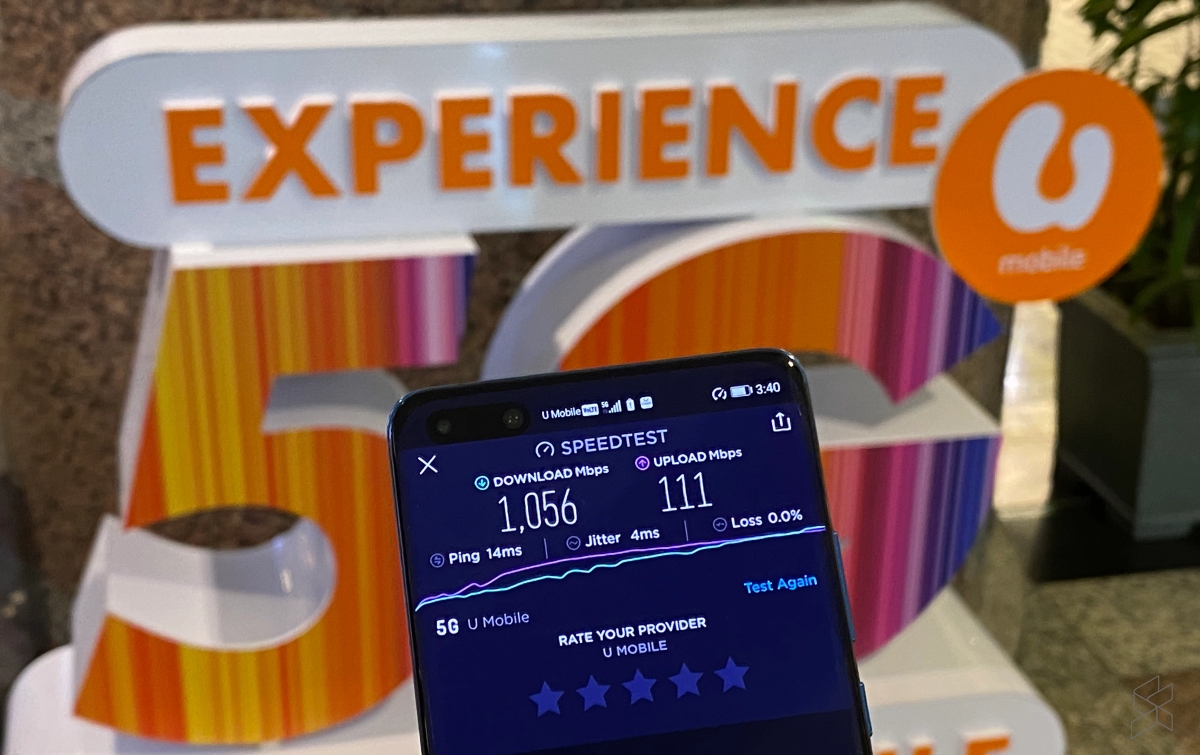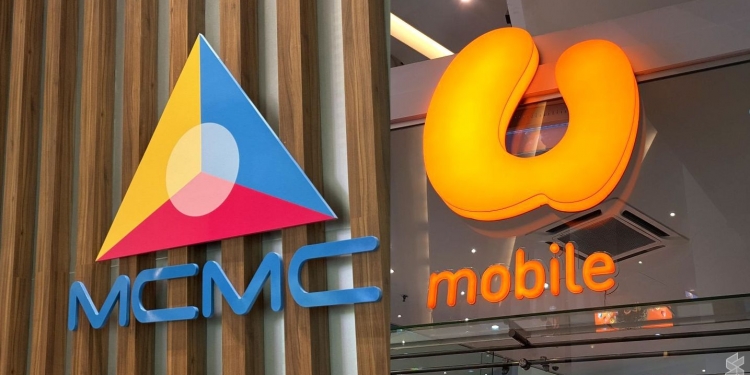[ UPDATE 6/11/2024 22:00 ] MCMC has updated its statement which now includes an updated FAQ on the second 5G network funding.
===
Following concerns raised by the public on the second 5G network selection, the Malaysian Communications and Multimedia Commission (MCMC) has issued an official response explaining why U Mobile was picked to carry out the large-scale 5G project.
According to the regulator, the decision to select U Mobile for the second 5G network implementation was based on a combination of factors which include business and technical plans, consumer complaints and satisfaction records, and its performance in carrying out other infrastructure initiatives. This includes contributions to the Universal Service Provision (USP) projects such as JENDELA Phase 1 and other 4G upgrading projects, in line with MCMC’s commitment to improve consumer experience and service excellence.
KENYATAAN MEDIA
— MCMC (@MCMC_RASMI) November 6, 2024
PEMILIHAN U MOBILE SDN BHD SEBAGAI PENYEDIA RANGKAIAN 5G KEDUA#MCMC pic.twitter.com/XEwPB08wJw
MCMC added that through the selection, regulatory responsibilities towards U Mobile will be enforced based on existing regulations. If there is any non-compliance, a penalty will be imposed towards the telco.
The regulator added that U Mobile as a second 5G network provider is allowed to partner with other ecosystem partners, subject to approval of the regulator. MCMC said it will evaluate the partnership to ensure that its benefits can be enjoyed by all Malaysians. It added U Mobile must inform MCMC if there are any changes to its foreign shareholding.
MCMC said the establishment of a second 5G network will open up opportunities for greater flexibility and inclusive services in the future. It added that the latest developments will encourage competition and strengthen industry resilience as well as enable Malaysians to enjoy high-speed connectivity at reasonable prices. The regulator added it will continue to monitor the quality standards among all service providers to ensure a solid and trusted telecommunications landscape for the future of the country.

In their updated FAQ, MCMC said the second 5G network will be fully funded by the private sector. It said no public funds will be allocated to the development of the second 5G network and U Mobile Sdn Bhd will be assigned 5G spectrum for the deployment. MCMC added that U Mobile will be charged relevant fees in accordance with the Communications and Multimedia Act 1998 and the Communications and Multimedia (Spectrum) Regulations 2000.
Questions remained unanswered

The latest statement issued by MCMC still doesn’t address glaring concerns about why U Mobile, a telco with fewer sites, subscribers and revenue, is selected over CelcomDigi and Maxis for the second 5G implementation.
To recap, U Mobile claims to more than 9,000 sites and is said to have over 9 million subscribers in 2023. As a comparison, CelcomDigi has 25,000 sites (post-merger) and 20.2 million subscribers, while Maxis has over 11,000 sites and 12.7 million subscribers.
As highlighted by analysts, U Mobile requires a financially strong partner to roll out a new 5G network which will compete with Digital Nasional Berhad.
U Mobile said last Saturday that it is excited to work with CelcomDigi and TM to build the second 5G network, however, there’s no official confirmation from CelcomDigi and TM on a possible collaboration. The orange telco, which is currently 48.3% owned by Singapore’s Straits Mobile Investments Pte Ltd, also announced that it will reduce its foreign majority shareholding to 20%.
In fact, CelcomDigi iterated that it had presented a compelling technical and commercial proposal to build the second 5G network and it was ready to commence nationwide rollout almost immediately after the spectrum award to build a 5G network to match its existing 4G and 4G+ network within the shortest time possible.
The merged telco is currently undergoing a massive network integration and modernisation exercise which is described as the largest network deployment project in Malaysia. CelcomDigi is seen as one of the forerunners in the second 5G network race as it aims to have 18,000 5G-ready sites by the end of 2025. Among all the telcos, CelcomDigi is poised to have the ability to roll out 5G the quickest.

If a telco’s accomplishment in JENDELA Phase 1 is a major criterion for the second 5G network tender, Maxis would have been a clear winner as it had completed the most base station upgrades and is the only telco to have completed its new 4G tower target for Phase 1.
Another question mark is the mandated target for the second 5G network rollout. If DNB is used as a benchmark, the new 5G network needs to deliver 80% 5G coverage in less than two years. To ensure a dual 5G network that works, it is vital that both 5G networks are able to operate sustainably and efficiently without incurring excessive costs.
[ SOURCE ]
Related reading
- Who owns U Mobile and how did it beat CelcomDigi and Maxis for second 5G network?
- Maxis wants to understand MCMC’s rationale to pick U Mobile for second 5G network
- CelcomDigi says it had presented compelling proposal for second 5G network, to consider several viable options ahead
- U Mobile eager to work with CelcomDigi and TM to build second 5G network, to reduce foreign majority shareholding to 20%
- TM acknowledges govt decision on second 5G network, to support rollout with its extensive fibre network
- MCMC: Malaysia’s second 5G network goes to U Mobile








